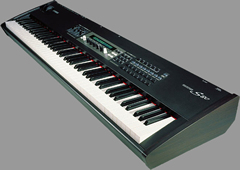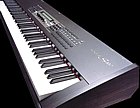| |
| INTRODUCTION |
 |
 |
Compact,
equipped with a 24 Mb AWM2 sound library and a 88 piano action keyboard,
the S80 provides high quality sounds and complete master keyboard
functions.
In addition to this, host computer port, CD-ROM sequencer/editor
software (supplied), SMF compatibility, songs and sounds storage
on Smart Media Card and, especially, the possibility of adding new
synthesis engines by installing a pair of optional Plug-in boards,
make the S80 an extremely flexible machine suitable for any musical
situation.
 Other
models: S30 and S90 Other
models: S30 and S90
 Modular
Synthesis Plug-In System Modular
Synthesis Plug-In System
 Bundled
software Bundled
software
 Technical
Details Technical
Details
|
|
| MAIN
PLUS |
 |
| |
The
strong points of this keyboard are the large sound palette, the MIDI
implementation, the Host connection, the great sound flexibility and
the affordable price.
More in details, these general concepts are based on the following
features.
|
 |
Large
polyphony, multitimbral capability and sound flexibility.
The S80 is able to play up to 64 notes simultaneously in the Voice
mode. In Performance mode it can play up to 16 sounds on 16 independent
MIDI channels.
Installing a Plug-in board both the poliphony and the multitimbral
Parts increase. It should be considered that the Plug-in boards system
is not just a sound library expansion but it is a convenient way to
customize the keyboard depending on the user synthesis needs.
At last, the Performance mode includes an additional "A/D" part for
connected microphones or line signals. The signal can be processed
by the S80 internal Effects too.
Sounds and Plug-In boards.
The S80 offers a wide range of high quality sounds useful in any musical
performance. The feeling is that the synthesizer has been designed
to give the user a complete sound palette, also able to stimulate
musical creativity and new ideas.
This is especially evident in the Performance mode, where the Arpeggio
function provides a variety of inspirating melodic phrases and rhythmic
sequences. S80 offers 256 Preset + 128 User Voices.
Moreover, 8 Preset + 2 Internal Drum sets are provided. On the other
hand, it should be not forgotten that the Plug-in boards installation
enables new synthesis engines. Therefore, S80 acts as a kind of sound
chamaleon, sounding in a complete different way depending on the synthesis
engine in use (i.e.:AWM2, AN, VL, FM synthesis). The possibility to
install up to 2 different sound generators is a big advantage for
the user, considering the future developments of the project.
|
 |
Fast
programming.
The S80 allows a fast fixing of any creative idea. Based on a limited
number of switches and knobs, its user interface gives an intuitive
and quick access to the different functions. For example, the convenient
Quick Access function allows an instant selection of the desired sound
based on the instrumental category. This function avoids time waste
in scrolling through the internal voices one at a time.
Voice editing is intuitive. It recalls the analog synthesizers programming.
Consequently it can be easily managed. At last, 12 powerful multi-mode
resonant filters are available for a more accurate sound shaping.
Bundled support software CD-ROM.
The S80 provides advanced features in sound editing and song programming
thanks to the Yamaha's own support software CD-ROM. This software
supports both Mac and PC platforms.
The applications include:
- Song programming through XGWorks lite software;
- Sound editing/creation through Voice Editor software, for an easy
management both of the internal AWM2 samples and the additional synthesis
generators available after Plug-in boards installation;
- Standard MIDI Files (format 0) management on Smart Media card through
Card filer software.
Host Computer port (serial interface).
The S80 built-in Host port allows a direct connection of the synthesizer
to the Mac or PC serial ports without any need of external MIDI interface.
This means that S80 and a computer can be the heart of a professional
studio able to satisfy any musical need (live applications, composing,
sound programming).
|
 |
Mass
storage.
The S80 uses a convenient and compact storage device, the Smart Media
card, easily available on the market. It allows to store Voices and
Performances as well as SMF sequences (type 0).
Obviously, the amount of stored data depends on the card capacity:
2/4/8/16 and 32 Mb cards can be used.
The card must be connected/disconnected only when the synthesizer
is switched off. By the supplied CD-ROM Card filer software it is
possible both to organize and modify the Smart Media card data (Voices
files and/or SMF song files) and to exchange data between computer
and card.
Moreover, the Chain song function, very useful in live performances,
enables the sequential playback of up to 100 songs.
Sound processing.
4 independent effect processors are available both for Voices and
Performances. They can be connected in series or in parallel, offering
an extensive range of possible configurations.
Two of them, named System effects, provide Reverb (12 types) and Chorus
(23 types) and affect the global sound (Voice or Performance). The
remaining two effects, named Insertion effects, can affect each element
composing the Voice or each Part of a Performance.
The Insertion 1 unit provides 24 effects (including flanger, auto-wah
and chorus) while the Insertion 2 provides 93 effects (i.e.: guitar
amplifier simulator, leslie, delay, etc.).
Therefore, the range of sound processing possibilities is huge. Moreover,
installing Plug-in boards adds more effects, obviously different from
those yet available on-board.
At last, the 4-band parametric EQ parameters are always available
on the display for a convenient real time sound control.
|
| |
 |
MIDI
Master Keyboard functions.
The MIDI implementation is complete, but limited in terms of transmit
channels. In Master Keyboard mode, in fact, S80 can play the internal
sounds (if required) and control external expanders transmitting on
a maximum of 4 MIDI channels.
The expanders control can be organized in layers with note limits,
in order to create splits when required. MIDI real time controls can
be assigned to wheels, sliders and pedals.
Moreover, the MIDI connected modules octave transpose can be directly
controlled thru the S80 MIDI tune transpose function without performing
any direct setting on the external unit. This function is very convenient
when the expander correct octave setting must be manteined independetly
from the S80 keyboard zone played.
Arpeggio notes and parameters can be MIDI transmitted too, allowing
a creative use of the connected sound modules. |
| |
|
INTERNAL
ARCHITECTURE
|
 |
|
|
The
S80 architecture includes Voices and Performances.
The smallest memory unit is the Voice, which can combine a maximum
of 4 elements (sounds). Each element can be a single or a multisampling
Sample.
On the other hand, a Performance can manage up to 16 Parts. Each Part
is a Voice assigned to a specific MIDI channel.
|
|

|
The
A/D input (for mic/line signals) and the 2 additional Plug-in boards
provide 3 additional Parts with independent polyphony and effects.
Therefore, a total of 19 Parts can be available.
Connecting external MIDI sound modules, the user can set each MIDI
transmission channel in order to play both the S80 and the external
unit or just one of them. |
| |
|
CONCLUSIONS
|
 |
|
|
The
S80 combines a stage-piano feeling (excellent weighted keyboard) with
high quality sounds, complete Master Keyboard functions and intuitive
user interface.
The synthesizer seems to have been projected for live performances.
This is quite evident considering the wide and effective range of
sounds on-board and the availability of assignable knobs and sliders
that facilitate the parameters real time control.
Nevertheless, the most interesting feature of S80 is the sound expansion
thru Plug-in boards. This system, in fact, doesn't increase just the
number of samples available, as it happens in other synthesizers,
but really provides different types of completely independent synthesis
engines.
Therefore, S80 can be considered as a very reliable and complete keyboard
still open to further implementations. |
|
 |



